Global Internet usage is the number of people who use the Internet worldwide.
Internet users
Main article: List of countries by number of Internet users
In 2015, the International Telecommunication Union estimated about 3.2 billion people, or almost half of the world's population, would be online by the end of the year. Of them, about 2 billion would be from developing countries, including 89 million from least developed countries. According to Hootsuite, the number of Global Internet users has already reached almost 5 billion, or about 53% of the global population as of 2021. The flat world of information has been created thanks to the Internet and globalization. This phenomenon allows individuals to have access to cultural and ideological beliefs without having to go to other countries, resulting in immobile acculturation.

Internet users per 100 inhabitants
Source: International Telecommunication Union.
Worldwide Internet users
|
2005 |
2010 |
2017 |
2023 |
| World population (billions) |
6.5 |
6.9 |
7.4 |
8.0 |
| Worldwide |
16% |
30% |
48% |
67% |
| In developing world |
8% |
21% |
41.3% |
60% |
| In developed world |
51% |
67% |
81% |
93% |
|
Internet users by region
| Region |
2005 |
2010 |
2017 |
2023 |
| Africa |
2% |
10% |
21.8% |
37% |
| Americas |
36% |
49% |
65.9% |
87% |
| Arab States |
8% |
26% |
43.7% |
69% |
| Asia and Pacific |
9% |
23% |
43.9% |
66% |
Commonwealth of
Independent States |
10% |
34% |
67.7% |
89% |
| Europe |
46% |
67% |
79.6% |
91% |
|
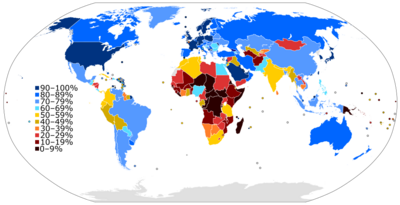
Internet users in 2015 as a percentage of a country's population
Source: International Telecommunication Union.
|
|
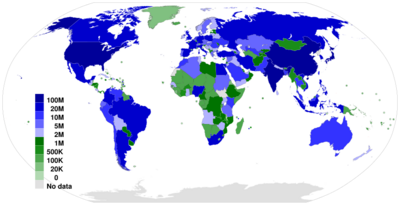
Number of Internet users in 2012
Source: International Telecommunication Union.
|

These maps illustrate the growth in the percentage of individuals using the Internet from 1990 to 2014.
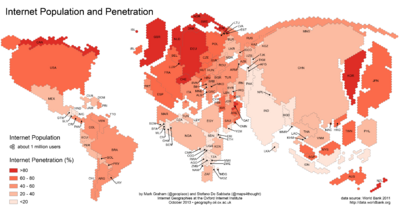
Number of Internet users in 2011
This map illustrates the total number of Internet users in a country as well as the percentage of the population that had Internet access in 2011.
Source: Information Geographies at the Oxford Internet Institute.
Broadband usage
Main article: List of sovereign states by number of broadband Internet subscriptions
Worldwide broadband subscriptions
| Users |
2007 |
2010 |
2016 |
2019 |
| World population |
6.6 billion |
6.9 billion |
7.3 billion |
7.75 billion |
| Fixed broadband |
5% |
8% |
11.9% |
14.5% |
| Developing world |
2% |
4% |
8.2% |
11.2% |
| Developed world |
18% |
24% |
30.1% |
33.6% |
| Mobile broadband |
4% |
11% |
49.4% |
83% |
| Developing world |
1% |
4% |
40.9% |
75.2% |
| Developed world |
19% |
43% |
90.3% |
121.7% |
|
|
Broadband subscriptions by region
| Subscription |
Place |
2007 |
2010 |
2014 |
2019 |
| Fixed |
Africa |
0.1% |
0.2% |
0.4% |
0.4% |
| Americas |
11% |
14% |
17% |
22% |
| Arab States |
1% |
2% |
3% |
8.1% |
| Asia and Pacific |
3% |
6% |
8% |
14.4% |
Commonwealth of
Independent States |
2% |
8% |
14% |
19.8% |
| Europe |
18% |
24% |
28% |
31.9% |
| Mobile |
Africa |
0.2% |
2% |
19% |
34% |
| Americas |
6% |
23% |
59% |
104.4% |
| Arab States |
0.8% |
5% |
25% |
67.3% |
| Asia and Pacific |
3% |
7% |
23% |
89% |
Commonwealth of
Independent States |
0.2% |
22% |
49% |
85.4% |
| Europe |
15% |
29% |
64% |
97.4% |
|
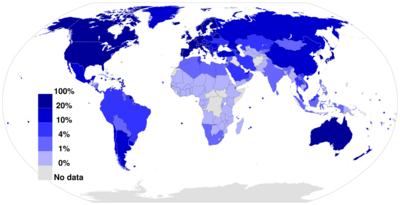
Fixed broadband Internet subscriptions in 2012
as a percentage of a country's population
Source: International Telecommunication Union.
|
|
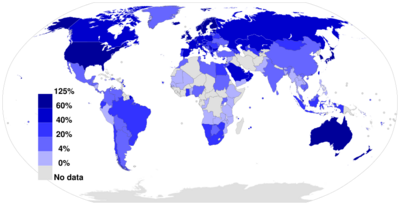
Mobile broadband Internet subscriptions in 2012
as a percentage of a country's population
Source: International Telecommunication Union.
|

Broadband affordability in 2011
This map presents an overview of broadband affordability, as the relationship between average yearly income per capita and the cost of a broadband subscription (data referring to 2011).
Source: Information Geographies at the Oxford Internet Institute.
Internet hosts
Main article: List of sovereign states by number of Internet hosts
The Internet Systems Consortium provides account for the number of the worldwide number of IPv4 hosts (see below). On 2019 this internet domain survey was discontinued as it does not account of IPv6 hosts, and therefore might be misleading.
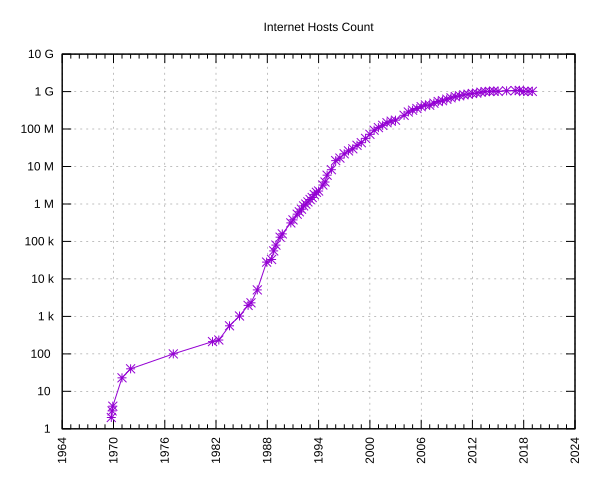
Source: Internet Systems Consortium.
Web index
Main article: Web Index
The Web index is a composite statistic designed and produced by the World Wide Web Foundation. It provides a multi-dimensional measure of the World Wide Web's contribution to development and human rights globally. It covers 86 countries as of 2014, the latest year for which the index has been compiled. It incorporates indicators that assess the areas of universal access, freedom and openness, relevant content, and empowerment, which indicate economic, social, and political impacts of the Web.

Map showing the score of the countries included in the Web index.
IPv4 addresses
Main articles: Carna botnet and List of countries by IPv4 address allocation
The Carna Botnet was a botnet of 420,000 devices created by hackers to measure the extent of the Internet in what the creators called the "Internet Census of 2012".

World map of 24-hour relative average utilization of IPv4 addresses observed using
ICMP ping requests as part of the Internet Census of 2012 (Carna Botnet), June – October 2012. Key: from red (high), to yellow, green (average), light blue, and dark blue (low).
Languages
Main article: Languages used on the Internet
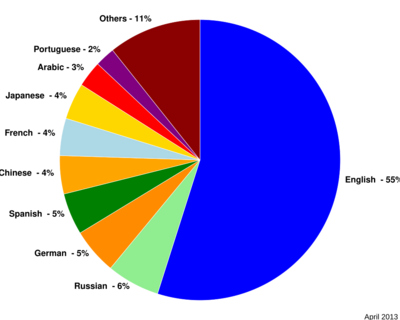
Content languages for websites
|
|
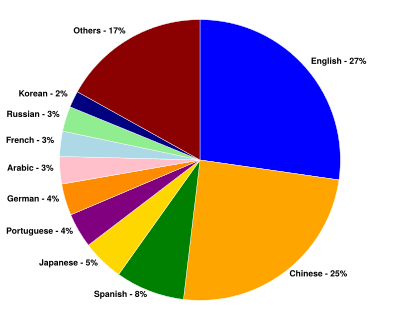
Percentage of Internet users by language
|
Censorship and surveillance
Main article: Internet censorship and surveillance by country

Internet censorship and surveillance by country (2018)
| Pervasive censorship and/or surveillance Substantial censorship and/or surveillance Selective censorship and/or surveillance |
Little or no censorship and/or surveillance Not classified / No data |
Sources: Freedom on the Net, OpenNet Initiative, Reporters Without Borders.
Main article: Censorship of YouTube

YouTube blocking by country
| Accessible, has local YouTube version Accessible |
Blocked Previously blocked |
See also
- A4AI: affordability threshold
- Digital rights
- Internet access
- Internet traffic
- List of sovereign states by Internet connection speeds
- List of countries by number of mobile phones in use
- List of social networking services
- Zettabyte Era
















